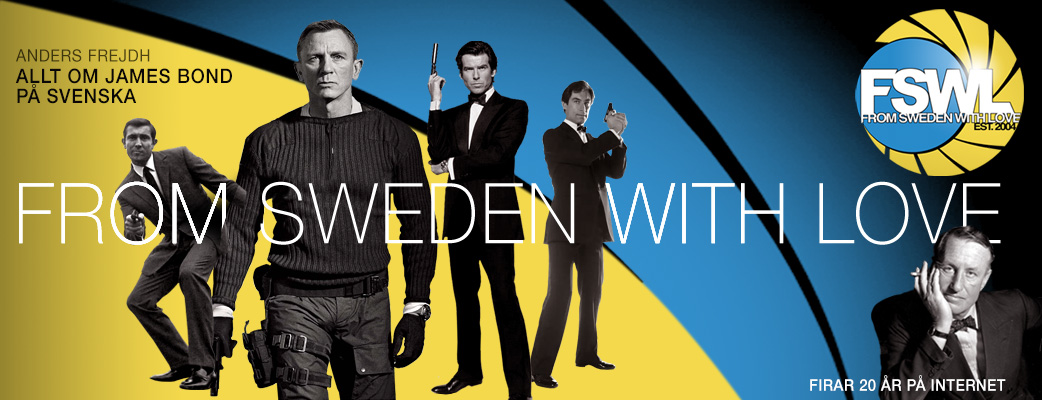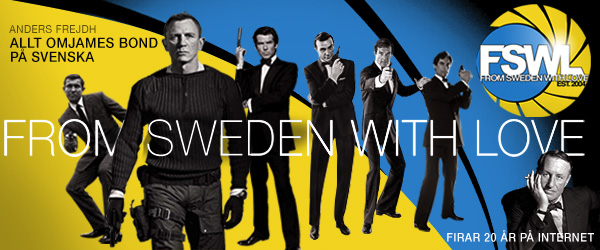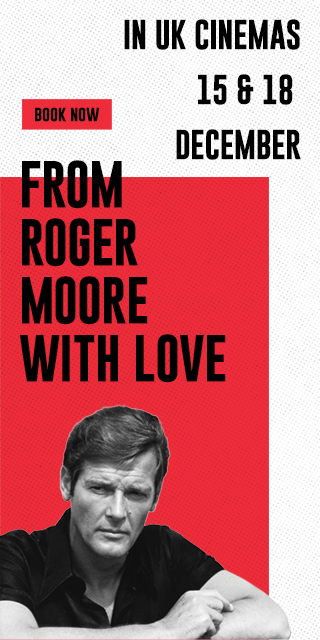Hemsidan senast uppdaterad: 2025-06-10
Hem
Bok- och filmrecensioner
Event
FSWL Merchandise
Intervjuer
James Bond 007 filmerna
James Bond 007 litteratur
James Bond 007 nyheter
James Bond 007 produkter
James Bond 007 samling
James Bond 007 shop
James Bond 007 spel
James Bond fanklubbar
James Bond personligheter
Svenskar i Bond-filmerna
TûÊvlingar
Till minne av
Rapport frûËn Bond At Bletchley Park: Illustrations & Inspirations
Av: Chris Johnson
Publicerad:
2018-06-06
2018-06-06
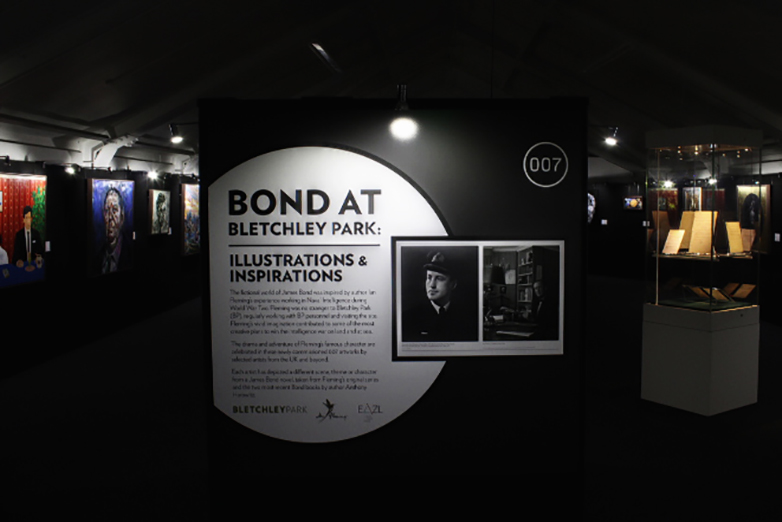

Dr David Kenyon, Bletchley Park's Research Historian, took to the stage and explained how he and his team of volunteer researchers searched through the National Archives to find out about Fleming's involvement with the code breaking team at Bletchley.
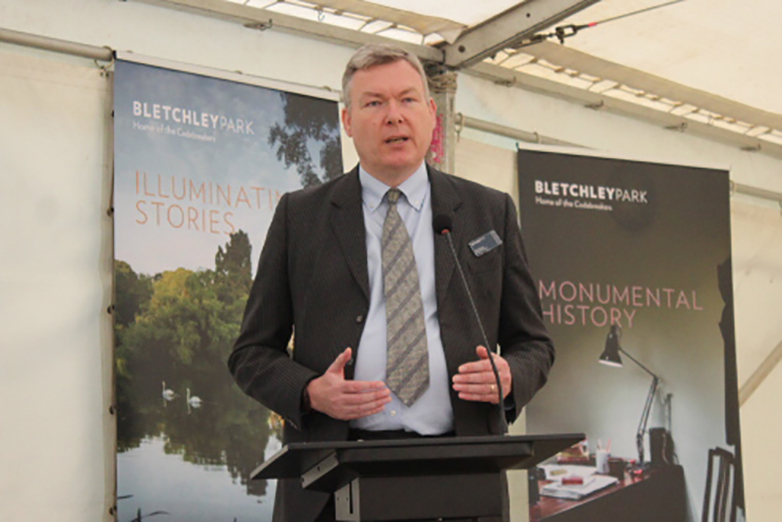
He continued to explain that during the Second World War, Fleming, at the age of 31, was headhunted and commissioned into the Royal Navy Volunteer Reserve (RNVR) and worked as Personal Assistant (PA) to the Head of Naval Intelligence, Admiral John Godfrey. Fleming also worked for his successor Admiral Edmund Rushbrooke. Despite the title of PA, Fleming's job role was a lot more important to the war effort. Dr Kenyon added what Admiral Godfrey once wrote:
ãI make a point of keeping Ian in touch with all aspects of NID (Naval Intelligence Division) work. He was the only officer who had a finger in practically every pie. I shared all secrets with him so that if I got knocked out someone else would we hoped be left to pick up the bits and achieve some sort of continuity.ã
This made me think that perhaps Fleming was in fact more like Bill Tanner than James Bond? A second-in-command that was there to step-in if ever something happened to the all-knowing head of the department that they worked for. Although Fleming was not the official liaison between Naval Intelligence and Bletchley Park, Admiral Godfrey did visit regularly. It is possible that Fleming accompanied him or perhaps even visited on his own. Although this can only be speculated. Kenyon said:
ãThe difficulty that we have is, perhaps fitting for someone that works in intelligence, tracking Fleming's exact movements is very difficult. There's no paper-trail of where he came and went. Although we know that Godfrey came on a number of occasions whether Fleming was with him is a bit more difficult to identify.ã
Over the years, biographers and researchers have thought that Fleming was not aware that Bletchley Park were making advances in being able to read the messages being sent by the Germans using the Enigma encoder, but Dr Kenyon was quick to dismiss this as false:
ãSome of Fleming's biographers have suggested that he wasn't necessarily completely au fait with the whole Enigma decryption and the Ultra story. One of the documents we have in the exhibition is in fact a list from 1941 from Naval Intelligence which lists firstly all the people that were allowed to know about Ultra but not read it and secondly all the people who were allowed to know about it and read it where relevant. Fleming is on the latter part of the list. We can say figuratively that he was reading Enigma intercepts.ã
A more specific element of Fleming's wartime work was also discussed. He was involved in arranging acts of 'Pinching'. This is the term that was given to acquiring German cipher and cryptography information and documentation. And this was particularly important to the efforts of all working at Bletchley Park as Dr Kenyon explained:
ãThe slight misapprehension about Enigma, partly fostered by the movie U751 is that the secret lies with the machine. The machine was well known publicly here in the 1920's and 1930's. The secret lies with the particular settings of the keys that you use when you operate the machine. Bletchley didn't really need an Enigma machine, but what they did need was the associated key setting books and paperwork like that.ã
It was because of this that Fleming came up with Operation Ruthless. A plan to fly a captured German bomber that was manned with an Allied aircrew and crash it into the Channel. They would send a distress signal and when a German ship arrived at the scene to help the supposedly stricken German crew, they would shoot the sailors and then sail back to an English port ã with their cargo of Enigma settings and other documents. Fleming also detailed that the crash should me made mid-channel so that there was more of a chance that the Germans would send a larger rescue vessel, increasing the chances of there being a greater amount of intelligence that could be acquired.
Although by today's standards this might sound like a suicide mission Operation Ruthless was initially approved in 1940. A Heinkel Bomber was acquired from the R.A.F. And was reinforced because its nose was made mainly of glass. Five gentlemen with a sufficient death wish were chosen to man the plane and they were placed on standby at an airbase in Dover, waiting for a time when the larger German rescue vessels were at sea and when the plane could tag onto the end of a German air-raid before making its crash-landing.
Unfortunately (or perhaps fortunately for the crew of the aircraft), such a time never occurred, and the crew were eventually told to stand down. Fleming was told to come up with a better idea.
Fleming also volunteered to be part of the crew. But because of his security clearance within Naval Intelligence it was considered too much of a risk.
The cancellation of Operation Ruthless caused disappointment within the corridors of Bletchley Park as they had been very keen to get their hands on the information that it could have secured. As Dr Kenyon explained during his presentation:
ãThere's a lovely minute from Frank Birch who was working as the Head of German Naval Section at the time here at Bletchley and he described: (Alan) Turing and (Peter) Twinn came to me like Undertakers cheated of a nice corpse two days ago. All in a stew about the cancellation of Operation Ruthless. The burden of their song was the importance of the Pinch.ã
Arguably though, Fleming did come up with a better idea which would have, indirectly helped the work done at Bletchley Park. He was instrumental to the creation of 30 Assault Unit. This was a Commando Unit that had the specific task of being on the front line and perform 'Pinches' from targets on land capturing enemy intelligence. 30 Assault Unit worked very well throughout the Mediterranean and Europe. One of their biggest successes was in 1945 where they arrived at Tambach Castle in Bavaria and were able to secure the entire German Navy Archive dating back to 1850 ã over 400 tonnes of documentation!
Dr David Kenyon ended his talk by explaining how the heritage of Fleming and 30 Assault Unit has been marked by a new unit with similar, contemporary aims:
ãIn some ways his legacy on that side of things lives on because from 2010 the Ministry of Defence decided that a similar role needed to be accomplished in modern military operations. The obvious example is seizing people's computers, grabbing mobile phones and all that intelligence material that exists on the battlefield today. And we now have in the ranks of the Royal Marines the 30 Commando Information Exploitation Group who do exactly what 30 Assault Unit did in the war. The name 30 Commando was given to them to make that explicit link. So, Fleming's legacy lives on with our modern armed forces.ã
It was then that Anthony Horowitz took to the stage. I will make no pretence ã I am a huge Anthony Horowitz fan. I have been since I have read all the Alex Rider books. I also greatly admire his other works including his Sherlock Holmes novels The House of Silk and Moriarty, and the more recent The Magpie Murders and The Word Is Murder.
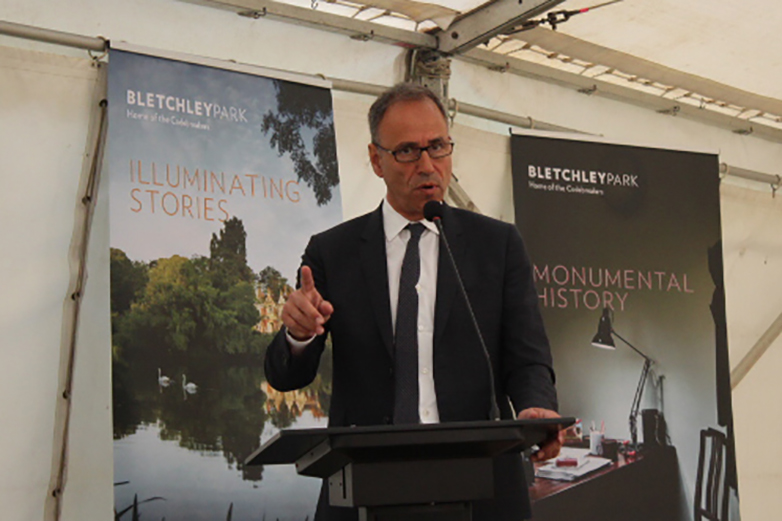
Horowitz started a brief talk about Fleming and his pre-war life. It was obvious in the way in which he spoke that he not only held Fleming in high regard from a technical point of view as a fellow writer, but that he was also a great fan of his works and genuinely enjoyed the James Bond books. Anthony then went on to share with his audience what he thinks was the defining moment in Ian Fleming's life:
ãThe making of Ian Fleming, in some respects is 24 May 1939 when as you've just heard he was co-opted, or joined rather, Naval Intelligence under John Godfrey. And so much of what happened then ã incidentally his rank was Commander, a rank that he would later share with character Bond ã so much of what went into the Bond novels comes out of that period in his life. Not just Naval Intelligence, but the Special Operations Executive (SOE), and Bletchley Park as well, which he visited.ã
He then elaborated as to why he was particularly happy to be visiting Bletchley Park for the first time on this day:
ãAs I stand here at Bletchley Park I have actually three strands coming together. One of which is Ian Fleming. The second is Foyles War, because for years and years I've been writing about the Second World War and in particular I've been interested in the work done here (Bletchley Park) and in the Special Operations Executive. The third strand of course is art. Let's not forget that today has an art exhibition that is related to and inspired by the works of Ian Fleming. Fleming himself took an enormous interest in the art of his books. He actually designed the first three covers for the books himself, those of Casino Royale, Live and Let Die and Moonraker ã and he took enormous interest in every aspect of those covers. Later on, he was instrumental in the hiring of Richard Chopping ã an artist who was known at the time for his extrovert lifestyle ã and insisted on Chopping designing the covers for the next books, which are now iconic, and one cannot imagine the books without them.ã
As his talk ended, Anthony told the audience what he hoped would happen when people read his James Bond novels:
ãIf there is one reason for me to write the continuation novels, not that I like them being called that. I never know what to call them. Homage? Pastiche? Parodies? They are novels written with a great love of their creator (Fleming), purely and simply. And the main reason that I write them is that I hope people will pick up Trigger Mortis and now Forever and a Day, enjoy what they read and go onto discover and read the genius of the original books.ã
As a fan of both Ian Fleming and Anthony Horowitz I hope so too.
The assembled group then moved to Hut 12 ã which is home to the Ian Fleming and Bletchley Park Illustrations and Inspirations exhibition.
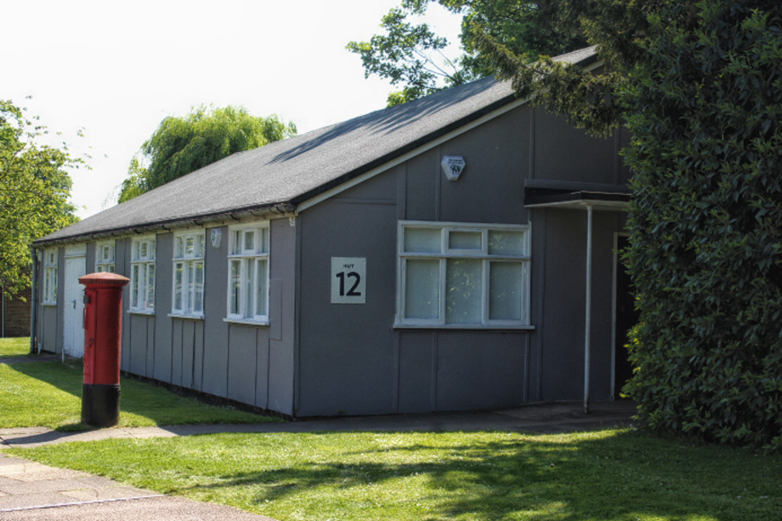
Inside we were greeted by an amazing display. Accompanying the 15-original works of art and the documentation, (some real and some copied), showing the link between Fleming and Bletchley Park there was a varied collection of hardback and paperback copies of the books of Ian Fleming, Kingsley Amis, John Gardner, Raymond Benson, Charlie Higson, Steve Cole and Anthony Horowitz. Both the book covers and the artwork ã all showing different interpretations of both the character of Bond and the adventure contained within.
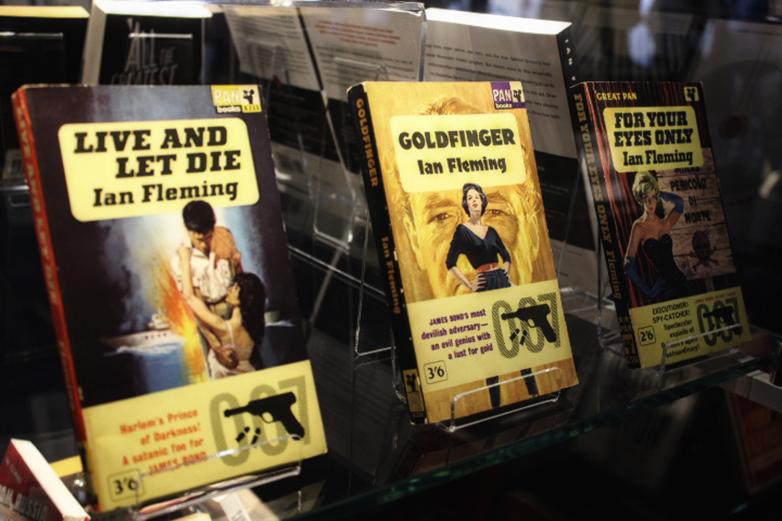
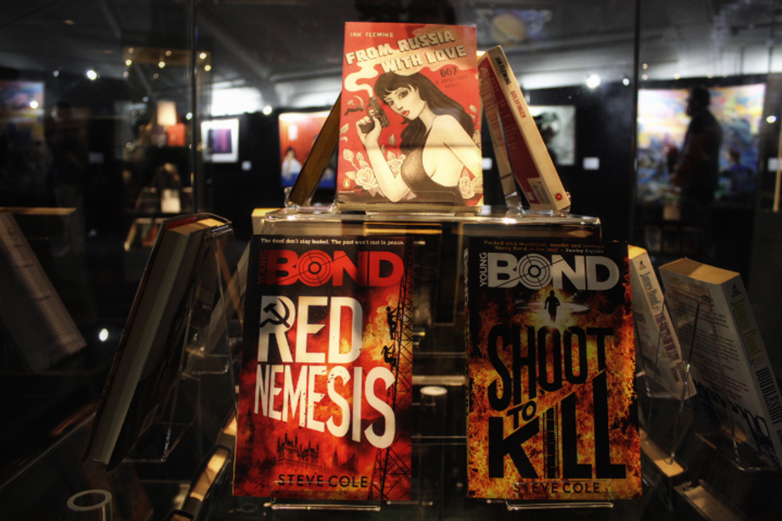
As we viewed the exhibition both Anthony Horowitz and Dr David Kenyon were on hand to answer questions for those visiting. Dr Kenyon explained to me about how the exhibition came to be:
ãWe were approached by Ian Fleming Publications with the concept of the exhibition and for us because Fleming is a part of our story we were very happy to go along with that project. It gave us an opportunity to tell an amazing story - to have an excuse to start really looking into the connection in detail because while a lot of books refer to Fleming and Bletchley Park as being linked the actual historical evidence for that hasn't necessarily been produced in the past.ã
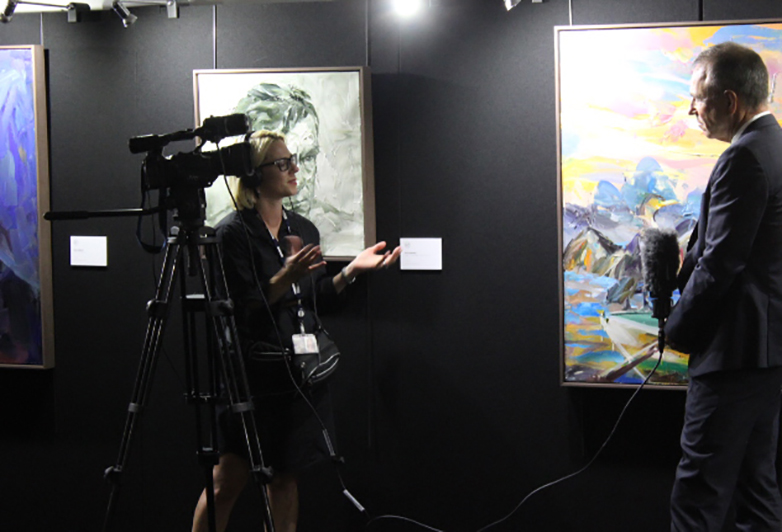
Anthony Horowitz also found time to answer a few of my questions. As someone who has been a fan of his work for a long time I felt a bit nervous because, but I soon felt as ease as I found myself talking to a fellow fan of Ian Fleming and James Bond, who coincidentally gets to write 007's adventures.
As I was there representing a Swedish James Bond website I thought that I would ask Anthony about how he researched Stockholm for the scenes in Forever And A Day where James Bond earns his Double-O Status by performing a rather nasty murder. He said:
ãI've been to Stockholm. I was there about 5 or 6 years ago. I have to be honest and say I didn't go back because I didn't, unfortunately, have time. But I have a good memory and I use photographic imagery. Don't forget that it is Stockholm in the 1950's so a lot of it is imagination which is true of the south of France as well. A great deal of what I describe in Nice, Monaco and Cannes are different to how it was. So, it's sort of part memory, part books and part imagination.ã
I also asked Anthony about his thoughts on Moonraker, Ian Fleming's book that in my opinion is often overlooked when people talk about the brilliance of Fleming's writing:
ãIt's one of my favourites. I absolutely adore it. There are so many things in the book that I like particularly the Bridge game at Blades that begins it. But also I like the Deal setting. I've set a book of my own down in Deal, which is The Word Is Murder which I even mention has a connection with Ian Fleming and it was rather fun to research it and go down there.
I love the Englishness of that book. I think it's absolutely one of the great things of it. When I was writing Trigger Mortis the sequences when he goes down to practice racing and the early chapters are very reminiscent of Moonraker.ã
Before heading home, I took a brief look round Bletchley Park and I found that I was leaving there with three things: A new found appreciation of the work Ian Fleming as both a writer and for his work with Naval Intelligence during the war. A better understanding of the importance of the work done at Bletchley Park. And lastly having met Anthony Horowitz, a feeling that the literary Bond is safe in his hands.
I hope that it will not take forever and a day for Ian Fleming Publications to ask Horowitz to write his third Bond novel.
Alla bilder och text av Chris Johnson. Copyright ôˋ 2018 From Sweden with Love. Alla rûÊttigheter fûÑrbehûËllna.
Taggar:
#anthony_horowitz
#artiklar
#artiklar
#forever_and_a_day
#utstallningar
Tweet
